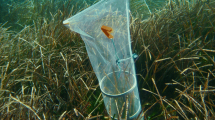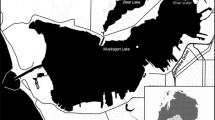Abstract
Hypoxia is emerging as a major threat to marine coastal biota. Predicting its occurrence and elucidating the driving factors are essential to set successful management targets to avoid its occurrence. This study aims to elucidate the effects of warming on the likelihood of hypoxia. High-frequency dissolved oxygen measurements have been used to estimate gross primary production (GPP), net ecosystem production (NEP) and community respiration (CR) in a shallow macroalgae (Caulerpa prolifera) ecosystem in a highly human-influenced closed Mediterranean bay. Daily averaged GPP and CR ranged from 0 to 1,240.9 and 51.4 to 1,297.3 mmol O2 m−2 day−1, respectively. The higher GPP and CR were calculated for the same day, when daily averaged water temperature was 28.3 °C, and resulted in a negative NEP of −56.4 mmol O2 m−2 day−1. The ecosystem was net heterotrophic during the studied period, probably subsidized by allochthonous organic inputs from ground waters and from the surrounding town and boating activity. Oxygen dynamics and metabolic rates strongly depend on water temperature, with lower oxygen content at higher temperatures. The probability of hypoxic conditions increased at a rate of 0.39 % °C−1 (±0.14 % °C−1). Global warming will increase the likelihood of hypoxia in the bay studied, as well as in other semi-enclosed bays.




Similar content being viewed by others
References
Barron, C., and C.M. Duarte. 2009. Dissolved organic matter release in a Posidonia oceanica meadow. Marine Ecology Progress Series 374: 75–84.
Basterretxea, G., A. Tovar-Sanchez, A.J. Beck, P. Masque, H.J. Bokuniewicz, R. Coffey, C.M. Duarte, J. Garcia-Orellana, E. Garcia-Solsona, L. Martinez-Ribes, and R. Vaquer-Sunyer. 2010. Submarine groundwater discharge to the coastal environment of a Mediterranean Island (Majorca, Spain): ecosystem and biogeochemical significance. Ecosystems 13: 629–643.
Brown, J.H., J.F. Gillooly, A.P. Allen, V.M. Savage, and G.B. West. 2004. Toward a metabolic theory of ecology. Ecology 85: 1771–1789.
Cade, B.S., and B.R. Noon. 2003. A gentle introduction to quantile regression for ecologists. Frontiers in Ecology and the Environment 1: 412–420.
Caffrey, J.M. 2004. Factors controlling net ecosystem metabolism in US estuaries. Estuaries 27: 90–101.
Carpenter, J. 1966. New measurements of oxygen solubility in pure and natural water. Limnology and Oceanography 11: 264–277.
Cole, J.J. 1982. Interactions between bacteria and algae in aquatic ecosystems. Annual Review of Ecology and Systematics 13: 291–314.
Cole, J.J., and N.F. Caraco. 1998. Atmospheric exchange of carbon dioxide in a low-wind oligotrophic lake measured by the addition of SF6. Limnology and Oceanography 43: 647–656.
Cole, J.J., M.L. Pace, S.R. Carpenter, and J.F. Kitchell. 2000. Persistence of net heterotrophy in lakes during nutrient addition and food web manipulations. Limnology and Oceanography 45: 1718–1730.
Coloso, J.J., J.J. Cole, P.C. Hanson, and M.L. Pace. 2008. Depth-integrated, continuous estimates of metabolism in a clear-water lake. Canadian Journal of Fisheries and Aquatic Sciences 65: 712–722.
Conley, D.J., J. Carstensen, R. Vaquer-Sunyer, and C.M. Duarte. 2009. Ecosystems thresholds with hypoxia. Hydrobiologia 629: 21–29.
Diaz, R.J. 2001. Overview of hypoxia around the world. Journal of Environmental Quality 30: 275–281.
Diaz, R.J., and R. Rosenberg. 1995. Marine benthic hypoxia: a review of its ecological effects and the behavioural responses of benthic macrofauna. Oceanography and Marine Biology: An Annual Review 33: 245–303.
Duarte, C.M. 1995. Submerged aquatic vegetation in relation to different nutrient regimes. Ophelia 41: 87–112.
Grall, J., and L. Chauvaud. 2002. Marine eutrophication and benthos: the need for new approaches and concepts. Global Change Biology 8: 813–830.
Grande, K.D., J. Marra, C. Langdon, K. Heinemann, and M.L. Bender. 1989. Rates of respiration in the light measured in marine-phytoplankton using an O-18 isotope-labeling technique. Journal of Experimental Marine Biology and Ecology 129: 95–120.
Haas, A.F., and C. Wild. 2010. Composition analysis of organic matter released by cosmopolitan coral reef-associated green algae. Aquatic Biology 10: 131–138.
Haas, A.F., C. Jantzen, M.S. Naumann, R. Iglesias-Prieto, and C. Wild. 2010. Organic matter release by the dominant primary producers in a Caribbean reef lagoon: implication for in situ O2 availability. Marine Ecology Progress Series 409: 27–39.
Harris, L.A., C.M. Duarte, and S.W. Nixon. 2006. Allometric laws and prediction in estuarine and coastal ecology. Estuaries and Coasts 29: 340–344.
Holmer, M., C.M. Duarte, H.T.S. Boschker, and C. Barron. 2004. Carbon cycling and bacterial carbon sources in pristine and impacted Mediterranean seagrass sediments. Aquatic Microbial Ecology 36: 227–237.
Holmer, M., N. Marba, M. Lamote, and C.M. Duarte. 2009. Deterioration of sediment quality in seagrass meadows (Posidonia oceanica) invaded by macroalgae (Caulerpa sp.). Estuaries and Coasts 32: 456–466.
Hopkinson, C.S., and E.M. Smith. 2005. Estuarine respiration: an overview of benthic, pelagic, and whole system respiration. In Respiration in aquatic ecosystems, ed. P.A. del Giorgio and P.J.B. Williams, 123–147. New York: Oxford University Press.
Iriberri, J., A. Undurraga, A. Muela, and L. Egea. 1985. Heterotrophic bacterial-activity in coastal waters—functional-relationship of temperature and phytoplankton population. Ecological Modelling 28: 113–120.
Jones, R.I. 1977. Importance of temperature conditioning to respiration of natural phytoplankton communities. British Phycological Journal 12: 277–285.
Karim, M.R., M. Sekine, T. Higuchi, T. Imai, and M. Ukita. 2003. Simulation of fish behavior and mortality in hypoxic water in an enclosed bay. Ecological Modelling 159: 27–42.
Kemp, W.M., E.M. Smith, M. MarvinDiPasquale, and W.R. Boynton. 1997. Organic carbon balance and net ecosystem metabolism in Chesapeake Bay. Marine Ecology Progress Series 150: 229–248.
Kihm, C., and A. Kortzinger. 2010. Air-sea gas transfer velocity for oxygen derived from float data. Journal of Geophysical Research-Oceans 115: C12003.
Lefevre, D., T.L. Bentley, C. Robinson, S.P. Blight, and P.J.L. Williams. 1994. The temperature response of gross and net community production and respiration in time-varying assemblages of temperate marine micro-plankton. Journal of Experimental Marine Biology and Ecology 184: 201–215.
Lloret, J., A. Marin, and L. Marin-Guirao. 2008. Is coastal lagoon eutrophication likely to be aggravated by global climate change? Estuarine, Coastal and Shelf Science 78: 403–412.
Marbà, N., and C.M. Duarte. 2010. Mediterranean warming triggers seagrass (Posidonia oceanica) shoot mortality. Global Change Biology 16: 2366–2375.
Mateu-Vicens, G., A. Box, S. Deudero, and B. Rodriguez. 2010. Comparative analysis of epiphytic foraminifera in sediments colonized by seagrass Posidonia oceanica and invasive macroalgae Caulerpa spp. Journal of Foraminiferal Research 40: 134–147.
Odum, H.T. 1956. Primary production in flowing waters. Limnology and Oceanography 1: 102–117.
Odum, H.T., and C.M. Hoskin. 1958. Comparative studies on the metabolism of marine waters. Publications of the Institute of Marine Science, University Texas 8: 16–46.
Odum, H.T., and R.F. Wilson. 1962. Further studies on reaeration and metabolism of Texas Bays, 1958–1960. Publications of the Institute of Marine Science, University Texas 8: 23–55.
Pace, M.L., and Y.T. Prairie. 2005. Respiration in lakes. In Respiration in aquatic ecosystems, ed. P.A. del Giorgio and P.J.B. Williams, 103–121. Oxford: Oxford University Press.
Paerl, H.W. 2006. Assessing and managing nutrient-enhanced eutrophication in estuarine and coastal waters: interactive effects of human and climatic perturbations. Ecological Engineering 26: 40–54.
Pringault, O., V. Tassas, and E. Rochelle-Newall. 2007. Consequences of respiration in the light on the determination of production in pelagic systems. Biogeosciences 4: 105–114.
Raven, J.A., and R.J. Geider. 1988. Temperature and algal growth. New Phytologist 110: 441–461.
Regaudie-de-Gioux, A., and C.M. Duarte. 2012. Temperature dependence of planktonic metabolism in the ocean. Global Biogeochemical Cycles 26: GB1015.
Robinson, C., and P.J.L. Williams. 1993. Temperature and antarctic plankton community respiration. Journal of Plankton Research 15: 1035–1051.
Sanchez-Moyano, J.E., F.J. Estacio, E.M. Garcia-Adiego, and J.C. Garcia-Gomez. 2001. Effect of the vegetative cycle of Caulerpa prolifera on the spatio-temporal variation of invertebrate macrofauna. Aquatic Botany 70: 163–174.
Steckbauer, A., C.M. Duarte, J. Carstensen, R. Vaquer-Sunyer, and D.J. Conley. 2011. Ecosystem impacts of hypoxia: thresholds of hypoxia and pathways to recovery. Environmental Research Letters 6. doi:10.1088/1748-9326/6/2/025003.
Terrados, J. and J.D. Ros. 1992. The influence of temperature on seasonal-variation of Caulerpa-prolifera (Forsskal) Lamouroux photosynthesis and respiration. Journal of Experimental Marine Biology and Ecology 162:199-212.
Vaquer-Sunyer, R., and C.M. Duarte. 2008. Thresholds of hypoxia for marine biodiversity. Proceedings of the National Academy of Sciences of the United States of America 105: 15452–15457.
Vaquer-Sunyer, R., and C.M. Duarte. 2011. Temperature effects on oxygen thresholds for hypoxia in marine benthic organisms. Global Change Biology 17: 1788–1797.
Vaquer-Sunyer, R., C.M. Duarte, R. Santiago, P. Wassmann, and M. Reigstad. 2010. Experimental evaluation of planktonic respiration response to warming in the European Arctic Sector. Polar Biology 33: 1661–1671.
Venkiteswaran, J.J., L.I. Wassenaar, and S.L. Schiff. 2007. Dynamics of dissolved oxygen isotopic ratios: a transient model to quantify primary production, community respiration, and air-water exchange in aquatic ecosystems. Oecologia 153: 385–398.
Wada, S., M.N. Aoki, Y. Tsuchiya, T. Sato, H. Shinagawa, and T. Hama. 2007. Quantitative and qualitative analyses of dissolved organic matter released from Ecklonia cava Kjellman, in Oura bay, Shimoda, Izu Peninsula, Japan. Journal of Experimental Marine Biology and Ecology 349: 344–358.
Wanninkhof, R. 1992. Relationship between wind-speed and gas-exchange over the ocean. Journal of Geophysical Research-Oceans 97: 7373–7382.
Wanninkhof, R., and W.R. McGillis. 1999. A cubic relationship between air-sea CO2 exchange and wind speed. Geophysical Research Letters 26: 1889–1892.
Wild, C., W. Niggl, M.S. Naumann, and A.F. Haas. 2010. Organic matter release by Red Sea coral reef organisms-potential effects on microbial activity and in situ O2 availability. Marine Ecology Progress Series 411: 61–71.
Yvon-Durocher, G., J.I. Jones, M. Trimmer, G. Woodward, and J.M. Montoya. 2010. Warming alters the metabolic balance of ecosystems. Philosophical Transactions of the Royal Society B-Biological Sciences 365: 2117–2126.
Zhang, J., D. Gilbert, A.J. Gooday, L. Levin, S.W.A. Naqvi, J.J. Middelburg, M. Scranton, W. Ekau, A. Pena, B. Dewitte, T. Oguz, P.M.S. Monteiro, E. Urban, N.N. Rabalais, V. Ittekkot, W.M. Kemp, O. Ulloa, R. Elmgren, E. Escobar-Briones, and A.K. Van Der Plas. 2010. Natural and human-induced hypoxia and consequences for coastal areas: synthesis and future development. Biogeosciences 7: 1443–1467.
Ziegler, S., and R. Benner. 1998. Ecosystem metabolism in a subtropical, seagrass-dominated lagoon. Marine Ecology Progress Series 173: 1–12.
Acknowledgments
This research is a contribution to the “Water bodies in Europe: Integrative Systems to assess Ecological Status and Recovery (WISER)” project, funded by FP7 (contract 226273); the project MEDEICG, funded by the Spanish Ministry of Science and Innovation (number CTM2009-07013) and the project MARINERA, funded by the Spanish Government (Ref. CTM-2008-04183-E/MAR). R. Vaquer-Sunyer was funded by the WISER project. G. Jordà acknowledges a JAE-DOC contract funded by the Spanish research council (CSIC). We thank R. Martínez, L. Royo, M. Noguera and A. Steckbauer for help on sampling and J.C. Alonso for nutrient analysis. We want to thank J.J. Coloso for his generosity in sharing his MATLAB program with us.
Author information
Authors and Affiliations
Corresponding author
Electronic supplementary material
Below is the link to the electronic supplementary material.
ESM 1
(DOC 615 kb)
Rights and permissions
About this article
Cite this article
Vaquer-Sunyer, R., Duarte, C.M., Jordà, G. et al. Temperature Dependence of Oxygen Dynamics and Community Metabolism in a Shallow Mediterranean Macroalgal Meadow (Caulerpa prolifera). Estuaries and Coasts 35, 1182–1192 (2012). https://doi.org/10.1007/s12237-012-9514-y
Received:
Revised:
Accepted:
Published:
Issue Date:
DOI: https://doi.org/10.1007/s12237-012-9514-y




